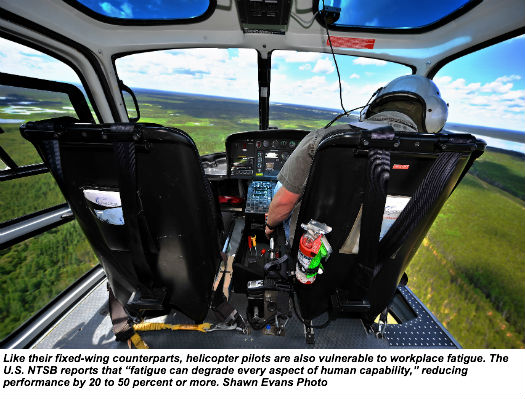
Transport Canada is joining a number of other regulators in enacting changes to fatigue risk management regulations that are backed by scientific research. In a notice of proposed amendment (NPA) issued on Sept. 15, Transport Canada published a series of planned legislative changes that it claims will enhance flight safety by reducing fatigue-related errors in the cockpit.
It’s a known fact that fatigue reduces mental and physical performance and is a contributing factor to workplace accidents. In aviation, crew fatigue has contributed to countless accidents and incidents. Such was the case in January 2012, when the crew of a Boeing 737-700 flew a faster-than-normal visual approach into Fort Nelson, B.C., forgot to disengage the autothrottle system, and subsequently overran the runway by 230 feet. Fortunately, there were no injuries or damage to the aircraft, however, Canada’s Transportation Safety Board determined that fatigue likely contributed to the flight crew’s poor judgment and inability to identify and manage operational risk.
Fatigue has a significant impact on helicopter operations, too. In 2012, the U.S. National Transportation Safety Board made an industry presentation at HAI’s Heli-Expo that stated: “Fatigue can degrade every aspect of human capability,” reducing performance by 20 to 50 per cent or more. The presentation identified helicopter accidents in which fatigue had played a part, identified factors associated with pilot fatigue, and made a series of recommendations to combat the danger. Among others, the NTSB advised regulators to consider a science-based approach to scheduling hours of service, one that would provide for at least eight hours of uninterrupted sleep and consider such things as the circadian clock, disorders such as sleep apnea, and hours spent awake.
Other notable industry groups are also working to combat flight crew fatigue. The International Civil Aviation Organization (ICAO), the International Air Transport Association (IATA), and the International Federation of Air Line Pilots’ Associations (IFALPA) came together in 2011 to release a Fatigue Risk Management System (FRMS) Implementation Guide for commercial aircraft operations. The plan recommends an FRMS approach, which is a data-driven method of evaluating fatigue-related risk, based on both scientific principles and operational best practices. Such a system could be integrated into existing safety management systems, advised ICAO.
In late 2011, the U.S. Federal Aviation Administration similarly amended its flight, duty and rest regulations for Part 121 passenger operations. The changes recommended a systems approach whereby both carriers and pilots accept responsibility for identifying and preventing crew fatigue. The European Aviation Safety Agency has also implemented a series of changes in line with FRMS recommendations.
Transport Canada is the latest regulator to announce its support for the principles behind an FRMS approach. The proposed changes will bring Canadian rules in line with ICAO standards and recommended practices (SARPs), thereby improving flight safety by integrating the latest scientific principles into fatigue risk management.
Recommendations are derived from an August 2012 report from the Flight Crew Fatigue Management Working Group, convened by the regulator and comprised of industry stakeholders.
Essentially, operators will be able to choose between a prescriptive, legislated approach to fatigue risk management, or a voluntary systems-based FRMS. While FRMS system implementation will not be mandatory, Transport Canada indicates that the option is “available as an alternate fatigue management scheme.”
Among a list of recommended changes, operators will be required to provide a schedule that permits sufficient crew rest, closely monitor flight and duty time data, and require that crew members declare themselves fit for duty prior to beginning their shift. Crew members must use allocated time off to rest, while monitoring their own level of readiness for duty, and reporting if they become unfit at any time.
Read the full Transport Canada NPA. Industry has until Oct. 3 to submit written comments on the proposed changes to carrac@tc.gc.ca. After that date, the amendments will be drafted and published in Canada Gazette, Part 1, at which point there will be an opportunity to provide additional feedback.
Once the proposed regulatory amendments are finalized, changes will be immediately applicable to CAR 704 and 705 air operator certificate holders (commuter and airline operations), while 702 and 703 operators (aerial work and air taxi operations) will have two years to comply with the new regulations.









